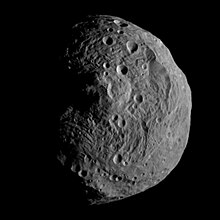Rheasylvia
Rheasilvia is the most visible surface feature on the asteroid Vesta and is believed to be an impact crater .
It measures 505 km in diameter, corresponding to 90% of the diameter of Vesta, or 89% of the mean equatorial diameter of 569 km. This makes it one of the largest craters in the solar system . It covers most of the southern hemisphere at 75 ° south longitude . The central mountain in the middle of the crater rises up to 22 km above the ground, making it the highest mountain in the solar system .
discovery
Rheasilvia was spotted in 1997 photos from the Hubble Space Telescope , but was not named until 2011, a year after the arrival of the Dawn spacecraft . The name comes from Rhea Silvia , a vestal virgin and the mother of the founders of Rome .
properties
The crater partially obscures an older crater called Veneneia , which is 395 km in size. At the same time, Rheasilvia has a rock wall that is 4 to 12 km above the surrounding area and partially runs along the perimeter . The bottom of the crater is about 13 km below the surrounding area. The basin consists of hilly terrain and a mountain that is approximately 200 km in diameter and 22 km tall. Spectroscopic analysis of the Hubble images showed that the crater penetrated through different layers of the crust and possibly even through the mantle. This is presumed based on various spectral characteristics of olivines . Vesta has a series of troughs in the equatorial region, concentric around Rheasylvia. It is believed that there are large-format fractures that occurred during the impact . The largest is Divalia Fossa , about 22 km wide and 465 km long. It is estimated that the impact dispersed about 1% of Vesta's volume. Presumably the Vesta family and the V asteroids are a product of this collision.
Given that, the fact that 10 km fragments survived the impact could indicate that the crater is around 1 billion years old. At the same time, this could also be the origin of the HED meteorites . The well-known V-type asteroids represent 6% of the excavated volume. The remainder is probably too small to be observed, or has been carried to the Kirkwood gap by the Jarkowski effect or (in the case of smaller fragments) by the radiation pressure .
Individual evidence
- ↑ Rheasilvia in the Gazetteer of Planetary Nomenclature of the IAU (WGPSN) / USGS
- ↑ Hubble Reveals Huge Crater on the Surface of the Asteroid Vesta
- ↑ Vesta seems more planet than asteroid. In: Science News. March 22, 2012.
- ↑ P. Vega: New View of Vesta Mountain From NASA's Dawn Mission . In: Jet Propulsion Lab's Dawn mission web site . NASA . October 11, 2011. Archived from the original on October 22, 2011. Retrieved on June 28, 2019.
- ↑ PC Thomas, et al .: Vesta: Spin Pole, Size, and Shape from HST Images . In: Icarus . 128, No. 1, 1997, p. 88. bibcode : 1997Icar..128 ... 88T . doi : 10.1006 / icar.1997.5736 .
- ^ RP Binzel, et al .: Geologic Mapping of Vesta from 1994 Hubble Space Telescope Images . In: Icarus . 128, No. 1, 1997, p. 95. bibcode : 1997Icar..128 ... 95B . doi : 10.1006 / icar.1997.5734 .

